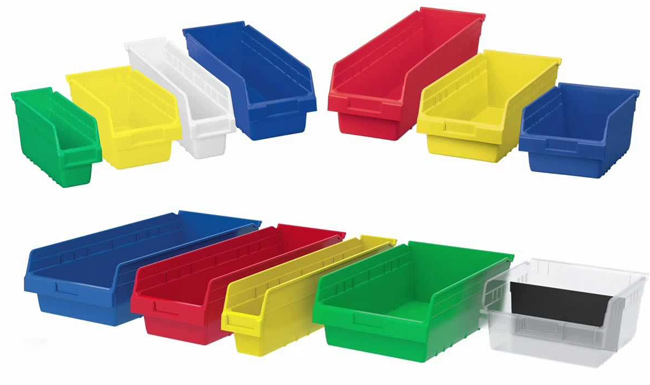
How Vendor Managed Inventory (VMI) Strengthens Supply Chain Resilience and Collaboration
To optimize inventory management, retailers and suppliers are increasingly turning to Vendor Managed Inventory (VMI) tools that transfer the responsibility…
Generix Ushers in a New Era of Intelligent Commerce for Retailers with AI-Driven Innovation Read the press release

Is the overall environmental impact of using plastic containers instead of cardboard boxes or even wooden pallets positive or negative? And how about the ROI and logistical efficiency? Let’s compare reusable plastic bins with their cardboard boxes counterparts and gain a deeper understanding of the environmental, societal and economic impact of using either of these alternatives.
Let’s summarize and compare the main characteristics of reusable bins and cardboard boxes that are commonly found on the market.
Plastic Bins Cardboard Box Average Price 35.92 $US/bin 0.50 $US/box Lifespan 10 to 15 years N/A Weight (average) 0.91 kg to 1.36 kg 0.46 kg Maximun Capacity (weight) 65 lbs 20 lbs Volume Capacity 1.2 cu. ft. 0.195 cu. ft. Manufacturer Akro-Mils* Various Material High Density Polyethylene (HDPE) Cardboard Carbon footprint 1.48 kg CO2 e/kg 0.538 kg CO2 e/kg Carbon footprint for a 3 lbs reusable plastic container 2.01 kg CO2 e/bin 0.243 kg CO2 eq/box
There are several reasons why customers purchase reusable containers. Here are the top 6 reasons:
1. They are very resistant, and therefore have a long lifespan (10-15 years)
2. They allow to protect materials, especially when they are fragile or when they require to be handled with care
3. The reusable bins can be closed. Therefore, they can be stacked vertically with up to 7-10 bins in one column, depending on their weight. This is not the case with the alternatives, which include pallets or cardboard boxes as these are not strong enough to be stacked.
4. They are easy for employees to handle. The maximum capacity in terms of weight and volume allows for better control of the risk of accidents when it comes to handling of these containers during the picking, packaging and shipping processes. The container cannot exceed the weight of 65 lbs.
5. According to WHO and CAT blog reusable bins do not generate dust, since dust is a problem for employees in a warehouse and can cause respiratory problems
6. HDPE has the smallest carbon footprint of all plastics types.
As far as the disadvantages are concerned, the only disadvantage systematically reported by employees is the issue of volume. Reusable containers are well suited for small household orders due to their limited volume (even for the larger bins). However, when the time comes to prepare large orders, users have no choice but to use pallets to deposit the goods.
On the other hand, what are the advantages of the cardboard boxes? If we consider a 1:1 ratio, it is clear that a cardboard box causes much less environmental damage than a plastic container does. However, depending on the volume of customer activity, reusable RPC can quickly prove to be an attractive choice, even if we only consider the cost. In the long term, RFC use has a positive impact on the environment, since all of the cardboard boxes used over the lifetime of a reusable bin will probably leave a larger ecological footprint.
Based on the data compiled and presented above, reusable HDPE container present several arguments in its favour with respect to sustainable development.
HDPE containers are a much cheaper supply chain tool than cardboard boxes are, whether we compare one container for an equivalent number of boxes or simply consider the fact that the bins allow for better products care when compared to pallets or boxes and prevent breakage.
The carbon footprint of HDPE is one of the lowest among all plastics types, and, is also smaller than that of an equivalent number of cardboard boxes per container.
If we look at the health and safety side, reusable HDPE containers are less harmful to employee health than the cardboard boxes (much less dust) and even the wooden pallets (dust and splinters).
Of course, these advantages come with an assumption that the RPC asset is properly used during its useful life and is properly disposed of at the end of its lifecycle. Indeed, HDPE containers can be properly recycled. Doing otherwise, would not serve well the interests of our fragile little planet.
Most WMS’s easily allow the use of the RPC via their standard configuration. If your company does not use these functionalities, it would certainly be interesting to find out more about this option in order to explore the possibilities of implementation.
Solutions exist today that can ensure any warehouse or distribution center operates at peak efficiency, 24 hours a day, seven days a week. From Warehouse Management Systems (WMS) and Transportation Management Systems (TMS) to Manufacturing Execution Systems (MES) and more, software platforms can deliver a wide range of benefits that ultimately flow to the warehouse operator’s bottom line.
Generix Group North America provides a series of solutions within our Supply Chain Hub product suite to create efficiencies across an entire supply chain. Our solutions are in use around the world and our experience is second-to-none. We invite you to contact us to learn more.

To optimize inventory management, retailers and suppliers are increasingly turning to Vendor Managed Inventory (VMI) tools that transfer the responsibility…

In an ever-evolving logistics environment, agile and precise warehouse resource management is essential to remain competitive. With increasing volumes driven…

France’s electronic invoicing reform relies on a Y-architecture, where Partner Dematerialization Providers (PDPs) play a central role in issuing and…

Work with our team to build your ideal supply chain software stack and tailor it to your unique business needs.